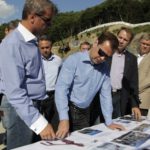News from Russia, Iran and Japan
Tuesday's World Events — Posted on September 6, 2011
RUSSIA – Russians test winter weather-altering technology in bid to control Olympic snow
SOCHI, Russia — Russia was embarking on an experiment with weather-altering technology in an attempt to control the snowfall at the country’s first Winter Olympics in 2014, the RIA Novosti news agency reported Friday.

Russian President Dmitry Medvedev, center, and Sberbank CEO German Gref, left, inspecting Sochi 2014 Winter Olympics facilities construction in Sochi.
The Games will be hosted in 2014 in the Black Sea resort of Sochi and organizers are desperate to avoid the effect of unpredictable weather that played havoc at the Vancouver Olympics last year.
Canadian officials were forced to truck in snow after heavy sun left Cypress Mountain practically bare, while at other times events were delayed because of heavy downpours.
Russia has used weather-altering practices before, pouring chemicals into clouds from planes to provoke precipitation, but it has never attempted them in the North Caucasus mountain range above Sochi.
Meterologists have established monitoring stations across the region to keep track of the vastly fluctuating weather patterns, building a data bank that it hopes will help the organizers eventually conquer nature.
“The need to conduct investigations comes from the fact that the ‘weather has never been made’ in mountainous locations,” a statement on the Natural Resources Ministry website explained.
IRAN: United Nations Says evidence Iran working on nuke weapons
VIENNA – The U.N. nuclear [watchdog – the IAEA] said Wednesday it is “increasingly concerned” about a stream of intelligence suggesting that Iran continues to work secretly on developing a nuclear payload for a missile and other components of a nuclear weapons program.
In its report, the International Atomic Energy Agency [IAEA] said “many member states” are providing evidence for that assessment, describing the information it is receiving as credible, “extensive and comprehensive.”
The restricted 9-page report was made available Friday to The Associated Press, shortly after being shared internally with the 35 IAEA member nations and the U.N. Security Council. It also said Tehran has fulfilled a [vow it] made earlier this year [to] start installing equipment to enrich uranium at a new location — an underground bunker that is better protected from air attack than its present enrichment facilities.
Enrichment can produce both nuclear fuel and [weapons], and Tehran — which says it wants only to produce fuel with the technology — is under four sets of U.N. Security Council sanctions for refusing to freeze enrichment, which it says it needs for fuel only.
[Iran] also denies secretly experimenting with a nuclear weapons program and has blocked a four-year attempt by the IAEA to follow up on intelligence that it secretly designed blueprints linked to a nuclear payload on a missile, experimented with exploding a nuclear charge, and conducted work on other components of a weapons program. …..The phrase “increasingly concerned” has not appeared in previous reports discussing Iran’s alleged nuclear weapons work and reflects the frustration felt by IAEA chief Yukiya Amano over the lack of progress in his investigations.
His report said that choice of language is due to the “possible existence in Iran of past or current undisclosed nuclear related activities” linked to weapons work. In particular, said the report, the agency continues to receive new information about “activities related to the development of a nuclear payload for a missile.”
Acquired from “many” member states, the information possessed by the IAEA is “extensive and comprehensive … (and) broadly consistent and credible,” said the report.
JAPAN – Domino’s plans store on the Moon
TOKYO — The Japanese arm of Domino’s Pizza was taking public relations to new heights Thursday with plans to build the first pizzeria on the moon, The (London) Daily Telegraph reported.
The stunt follows rival chain Pizza Hut’s mission to the International Space Station in 2001, when a pizza was delivered to astronauts orbiting the earth.
“We started thinking about this project last year, although we have not yet determined when the restaurant might open,” spokesman Tomohide Matsunaga told the newspaper.
Domino’s said the Maeda construction company had begun drawing up plans for a two-story, dome-shaped lunar eatery. It added that the eatery’s staff would live on-site at the 28-yard-wide building.
The restaurant chain estimated that the cost of turning the stunt into reality would be about $21.8 billion.
Some 15 rockets would be required to deliver 70 tons of construction materials and pizza-making equipment to the moon.
“In the future, we anticipate there will be many people living on the moon — astronauts who are working there and, in the future, citizens of the moon,” Matsunaga added.
(The news briefs above are from wire reports and staff reports posted at NYPost.com and YahooNews.com on Sept. 2nd, and London’s Telegraph.co.uk on Sept. 1st [this story re-written in nypost.com and posted here.)
Background
RUSSIA: ON THE PRACTICE OF CLOUD-SEEDING:
- The United States began weather control research in 1946. Currently, some states use cloud-seeding programs in an attempt to increase precipitation levels or prevent crop-damaging hail. An eight-year experiment in Texas and Oklahoma, conducted over 5,000 square miles, showed that cloud seeding increased rainfall, cloud height, length of storms and the area in which rain fell. Even so, enthusiasm for cloud seeding in the U.S. has dried up since the early 1970s, when federal funding was about $19 million a year.
- Internationally, Russia, Israel, Thailand, South Africa and Caribbean nations have all tried their hand at cloud seeding, with mixed results. Australian scientists conducted numerous experiments, discovering that static seeding didn't appear to be effective over Australia's plains but was very effective over Tasmania.
- Despite some successful tests, cloud seeding still has many problems. The fundamental concern is:
Does it work? It may be a chicken-and-egg conundrum -- would it have rained in a given area without the use of cloud seeding, and would it have rained less? Cloud seeding also depends heavily on environmental conditions like temperature and cloud composition. - In 2003, the United States National Academy of Sciences declared that 30 years of studies had not produced "convincing" evidence that weather modification works. On the other hand, the American Meteorological Society claims that some studies on cloud seeding show a 10 percent increase in rain volume.
- Despite reassurances from cloud-seeding companies, concerns also remain about exposure to silver iodide toxicity and soil contamination. ...cloud seeding has strong supporters, but it remains controversial.
- Scientists may not be sure if cloud seeding actually works, but despite the skepticism, China is moving forward. The nation spends $60 to $90 million a year on weather modification, in addition to the $266 million spent from 1995 to 2003. ... (from science.howstuffworks.com/cloud-seeding2.htm)
----------------------------------------------------------------------
IRAN: Other findings of the IAEA report, prepared for a session of the IAEA's 35-nation board of governors starting Sept. 12 included:
— Confirmation of reports by diplomats to the Associated Press [AP] that Iran has started setting up uranium enriching centrifuges at Fordow, a fortified facility dug into a mountain near the holy city of Qom. Iran intends to use Fordow to triple its 20-percent enrichment of uranium — a concern because that level is easier to turn into weapons grade uranium more quickly than its main stockpile of low enriched uranium at 3.5 percent.
— Further accumulation of both low-enriched and higher enriched or 20 percent uranium. The report said Iran had now accumulated more than four tons of low enriched uranium and over 70 kilograms — more than 150 pounds — of higher enriched material. Those two stockpiles give it enough enriched uranium to make up to six nuclear warheads, should it choose to do so.
The report praised Iran for its decision earlier this month to allow IAEA Deputy Director General Herman Nackaerts to tour a facility where it is developing more efficient centrifuges, saying Iran "provided extensive information" on its development of such machines.
It, however was generally critical of Iran's record of secrecy and lack of cooperation, noting that without increased openness on the part of the Islamic Republic the IAEA is unable to "conclude that all nuclear material in Iran is in peaceful activities."
IRAN'S NUCLEAR PROGRAM:
- Iran's 20 year secret nuclear program was discovered in 2002. Iran says its program is for fuel purposes only, but it has been working on uranium enrichment which is used to make nuclear bombs.
- Under the United Nations' NPT (Non Proliferation Treaty) countries are not allowed to make nuclear weapons (except for the 5 that had nuclear weapons prior to the treaty - the U.S., Russia, China, France, the United Kingdom).
- Safeguards are used to verify compliance with the Treaty through inspections conducted by the UN's nuclear watchdog, the IAEA (International Atomic Energy Agency).
- The IAEA issued a report on Sept. 15, 2008 that said Iran has repeatedly blocked an investigation into its nuclear program and the probe is now deadlocked.
- A group of U.S. and Russian scientists said in a report issued in May 2009 that Iran could produce a simple nuclear device in one to three years and a nuclear warhead in another five years after that. The study, published by the nonpartisan EastWest Institute, also said Iran is making advances in rocket technology and could develop a ballistic missile capable of firing a 2,200-pound nuclear warhead up to 1,200 miles "in perhaps six to eight years."
- The U.N. Security Council has already imposed four sets of sanctions on Iran over its nuclear defiance. Despite the sanctions, Iran has refused to end its nuclear program.
- The Iranian government has called for the destruction of Israel on numerous occasions. It is believed that once obtained, Iranian President Ahmadinejad would use nuclear weapons against Israel.

